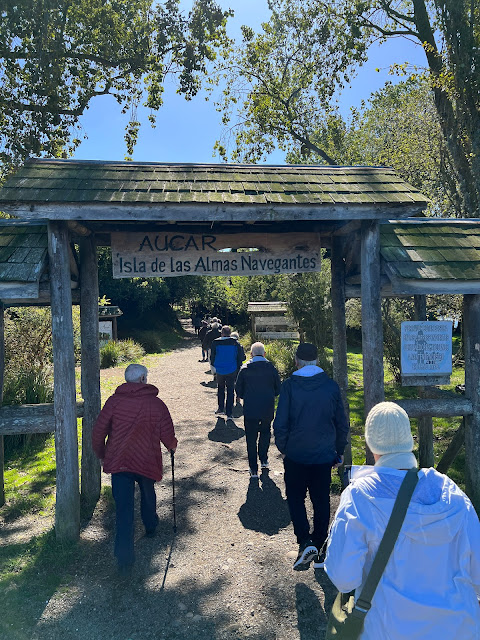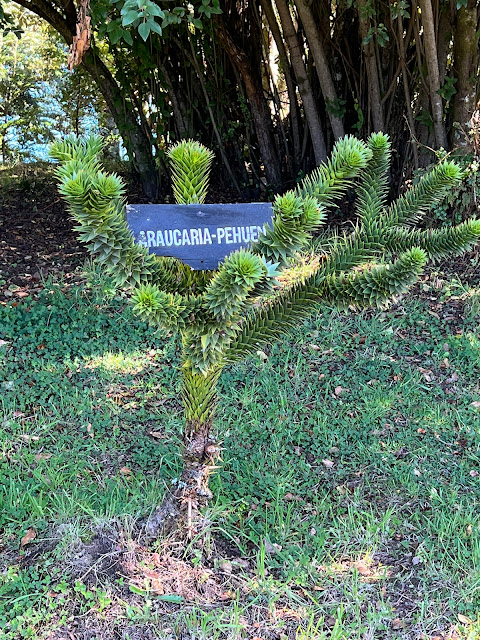 |
| Orange arrow points to Chiloe; red line is the length of Chile |
Chiloe Island in southern Chile is apparently a popular tourist destination. I can understand that as it is a delightful spot. Remembering that Chile is just over 4000km long, we had navigated 3400km from the beginning of our voyage yet we were not halfway north along this narrow coastal-strip of country - it's all those scribbly bits in and out of those stunning fjords. Unsurprisingly Chile has numerous climatic regions. We were in the Lake District within Chilean Patagonia and it is lush.
We disembarked at Quemchi a small fishing port on the east coast of the island and once ashore we were loaded into buses - ours with a fantastic guide Patrice - to drive through bucolic farmland to a tiny fishing village called Dalcahue, which means ‘place of canoes’. The canoes were made by stitching 3 pieces of ‘wood’ together with reeds and sealing the seams with vegetable glue. When we arrived there, we happened upon the preparations for the funeral for a well-loved and revered local so we had to be careful not to intrude too much on the grieving community but they allowed us to have a look inside the church, Iglesia de Nuestra Señora de los Dolores de Dalcahue, Church of Our Lady of Sorrows. It is one of the largest and oldest churches in Chiloe and was declared a National Monument in 1971 and listed as World Heritage by UNESCO in 2000.

When we emerged the crowd was gathering and among the crowd were a number in regional costume. It felt rather a special place and day. When we returned from the harbour maybe 45 minutes later, the crowd had grown and was still growing with many more people in regional costume including a number of grand-looking huaso (Chile's excellent horsemen). It seemed that there was to be a ‘celebration’ in dance and music. Quite moving for us for whom funerals are sombre affairs.
 |
| A quirky piece of artwork near the Square |
We wandered down to the harbour to check out the fishmongers and, if we dared, taste the exotic crustaceans – sea urchins amongst other ‘delicacies' including what to me looked like Cunjevoi (used as berley in some places in Australia). Our guide was persuaded to swallow one and it looked extremely unpleasant.
 |
| A striated heron was perched quietly on this little wooden boat |
 |
| Further out in the bay was an oyster farm and yes they were being sold on the wharf |
 |
| Most of us were gagging just watching Patrice down a largish slippery red morsel. |
 |
| The vibrant village market |
The rest of the market was quite fascinating. Again, sadly we just couldn't buy anything. Eventually we were rounded up and herded back onto the bus to travel back to Quemchi and to the tiny island of Aucar, called
Isla de las Almas Navegantes, translated means Island of Sailing Souls (lost sailors). The island is accessible via a long wooden footbridge.
 |
| Sailors cemetery |
The island was like a botanical garden with mainly trees endemic to the region. Fascinating. We also visited the tiny chapel on the island.
 |
| Then we all clip-clopped back across the bridge which was a bit rickety in places |
Sadly I have no pix but back on the mainland on the edge of the water there was a flock of black-necked swans. I've never seen them before and they are quiet lovely. Apparently they are found throughout the southern tip of South America. What a find for bird-lovers. The wee island was a beautiful little spot, In fact all that we saw of Chiloe was lovely.
That night there was a farewell cocktail party with the captain at which all the crew were presented. We managed to duck passed the Captain and the 'mandatory' formal pic with the Captain (we were not dressed for the occasion). Nor were we suirably attired for the formal Gala dinner which followed (not our scene) so we escaped to Le Boussole on Deck 6.

















No comments:
Post a Comment